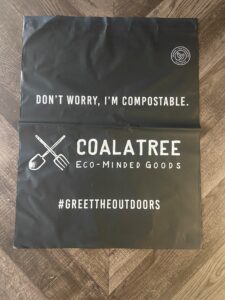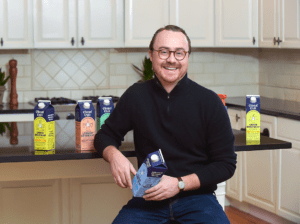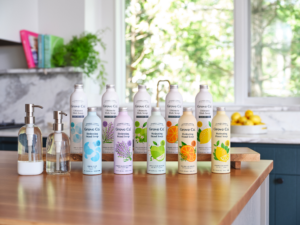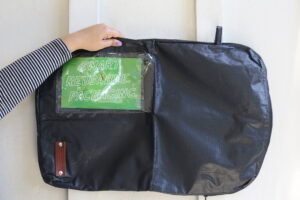Sustainability is part of Coalatree’s mission.
The performance apparel brand works to make its clothing in a sustainable way, such as designing products with sustainable materials like recycled water bottles and manufacturing its garments in factories that adhere to its standards, such as using a waterless dye method.
So when it comes to getting that product in a shopper’s hand, Coalatree prioritizes shipping it in a sustainable way, says John Michael Fabrizi, president and chief operating officer for the apparel brand.
“It doesn’t make sense for us to make products out of sustainable inputs and then on the flip side, ship things out in the least sustainable way possible,” Fabrizi says.
Coalatree ships its products in a compostable mailer, and the plastic polybags that encase each item are made from recycled plastic.
Fabrizi estimates that this packaging costs the brand about 25% more than what it would cost to use traditional shipping materials.
“We’re a pretty mission-driven brand, and that’s key to what we are doing, which is why these costs need to be factored into the business from the get-go. That’s why people buy our products,” Fabrizi says.
And therein lies the burden for all brands when it comes to sustainability — the cost. For brands with an eco-mission, including Coalatree, cleaning products brand Cleancult, household products brand Grove Collaborative and apparel brand Toad & Co., the extra cost of environmentally friendly shipping is worth it to them and, they believe, to their customers. And they’re constantly testing new packaging options coming to market as they seek to improve their offerings and minimize the cost of backing up their commitments to environmental responsibility.
Shoppers care about sustainable materials, but it costs retailers
The push to find eco-friendly ways to deliver online orders is a response to the concerns of many shoppers. 56.8% of consumers say sustainable packaging and shipping is important (33.8%) or very important (23%) when purchasing online, according to a March 2023 survey of 500 consumers by logistics software vendor Sifted.
What’s more, 69% of consumers say sustainable shipping has influenced their past purchases, and 76% of shoppers that they would pay an extra 5% for more shipping options that minimize environmental damage, according to the survey.
This large share of shoppers taking into account sustainable shipping does not surprise Caleb Nelson, chief growth officer at Sifted.
“Consumers are demanding sustainability improvements across the board, so we didn’t find it surprising that there’s such a demand for it when it comes to shipping,” Nelson says. “Ecommerce saw unprecedented growth during the pandemic, and that shift made a lot more consumers think about the impacts of having products shipped to their doorsteps.”
But that shift in thinking doesn’t mean it’s an easy decision for online retailers to discard traditional packaging materials and practices. Sustainable packaging is more expensive, and there is no guarantee that consumers’ desire to minimize environmental damage will actually change the shopping habits of many.
For now, the online retailers using eco-friendly packaging are the exceptions.
Globally, the ecommerce industry used nearly 2.1 billion pounds of plastic packaging in 2019, according to an analysis published in a 2020 report by Oceana Inc., a nonprofit organization dedicated to protecting oceans. Plastic packaging includes mailers, bubble-lined paper and plastic mailers, air pillows, shrink films and more. Amazon.com Inc. alone produced 465 million pounds of plastic packaging waste in 2019, according to the report.

Coalatree’s polybags and mailers are printed with messages like, “Don’t worry, I’m compostable,” or “Don’t worry I’m made of recycled materials,” which educates shoppers about the company’s environmental commitment.
“We are in the new part of the curve, where everyone thinks it’s a good idea and there’s some authentic application that is economical,” says Bernardine Wu, executive managing director of digital strategy at digital consultancy OSF Digital, referring to sustainable packaging. “But we’re not there yet in our industry with reusable packaging or materials that are better, or degradable. It’s not competitively cheaper.”
Meaning, there is not enough demand from retailers and shoppers for sustainable packaging for there to be enough vendors to make prices competitive. Wu draws an analogy to the food industry offering more plant-based foods. It took years to scale, but now consumers have multiple plant-based alternatives for foods that are comparable in price to meat products at the grocery store, she says.
Shervin Dehmoubed, founder and CEO of sustainable packaging vendor ecoPackables, says recycled plastic is just as durable as virgin plastic and costs about the same. At ecoPackables, compostable packages cost about 30-50% more than non-compostable alternatives, and recycled paper costs about 50-70% more, he says. Compostable packages include plant-based plastics. These materials, however, can be complicated for consumers to recycle as they require delivery to a special facility. If recycled improperly, they can contaminate good recycling and if thrown out, they can emit even more methane than traditional trash.
EcoPackables has been in business for four years and has more than 100 enterprise clients using its products, such as apparel retailers Ted Baker and Revolve, and more than 2,000 small businesses, many of them Etsy sellers.
LimeLoop is another vendor that offers reusable packaging to retailers. The vendor rents out reusable bags for $1 per bag per month that retailers can use to ship products to customers. Shoppers are asked to mail the bags back to the retailer. LimeLoop launched in 2018 and has 45 online retail clients, mostly small businesses with annual revenue less than $5 million. It does have some enterprise clients, with a handful more in the pipeline, a spokesperson says without revealing more.
No plastic in packaging
Like Coalatree, both Grove Collaborative and cleaning products brand Cleancult believe their stated brand missions require offering sustainable shipping to shoppers. And that means minimal to no plastic.
“We can’t use plastic. It can’t ruin our value proposition,” says Ryan Lupberger, co-founder and CEO of Cleancult.

Ryan Lupberger, co-founder and CEO of Cleancult.
Cleancult uses corrugated paper to pad its products, which is typically two to three times more expensive than plastic polybag filler, Lupberger says. It also pads its glass bottles with cardboard beds to ensure products don’t bump into each other.
The brand uses Forest Stewardship Council-certified paper for its product cartons and shipping boxes. FSC is a nonprofit organization that ensures the paper is from a forest that is responsibly managed for environmental, economic and social benefits.
Grove is plastic-neutral, meaning for every pound of plastic sold, it collects and recycles that same amount in nature through rePurpose Global, a plastic action platform that aims to reduce waste. Grove’s goal is to be plastic-free by 2025. To achieve its goals, Grove Collaborative continually seeks ways to improve its packaging.
When it comes to minimizing the carbon footprint of a fulfillment box, it’s all about lower weight, smaller size and less package, says CEO and co-founder Stuart Landesberg. Grove focuses on only selling products that are smaller in size — or changing them to make them smaller, and thus easier to ship. For example, instead of selling a full-size mop, which is bulky to ship, it made its broom stick collapsible to fit into a much smaller box. Similarly, it sells concentrated laundry detergent that shoppers can add water to at home, instead of full-size bottles which are large and heavy to ship.
That brings Landesberg to a tip for merchants striving to be more sustainable: Invest in multiple box sizes to minimize the number of packages that are larger than necessary.
“The best solution is well-trained labor and enough box sizes that you can match products to appropriately,” he says.
At one point, Grove experimented with 30 box sizes. Now, it has settled on its four boxes and two mailers, which can appropriately fit all of its orders.
Fitting all products into one box
Box size is important at Grove, as it prides itself on fitting all the products for an order — the average order size on Grove.co is eight to 10 products — into one box. This requires investment in its talent. Grove’s warehouse workers need to “Tetris” or puzzle together the fulfillment box so all the products fit inside, Landesberg says.
Packers receive a week of hands-on training, then a month of guided supervision as they learn how to pack the boxes and their expected goals. The position represents a promotion over an entry-level position and comes with more money. Landesberg declined to share its warehouse employee wages.

Grove is plastic-neutral, meaning for every pound of plastic sold, it collects and recycles that same amount in nature.
“The training process at Grove is longer than most ecommerce packer training programs because the nature of our product and packaging expectations requires a level of detail that isn’t always necessary in a traditional packing role,” Landesberg says. “Our team members understand the importance of optimizing products and packaging materials in such a way that does not contribute to a higher carbon footprint.”
Landesberg describes the role as a “pressure seat.” The employee receives the touts with the products picked for the order and the appropriately sized box. Then, they have to quickly fit it all in, as employees have a units-per-hour goal, and that goal increases according to their experience level and job function.
Other warehouses might use a robot to perform this task. But Grove is willing to pay a bit more to have this step of the fulfillment process done correctly.
“I haven’t seen anything robots can do as good as a human,” Landesberg says about this box-packing step. Grove weekly tracks customer satisfaction and feedback as the primary success metrics for Grove packers. Grove, a publicly traded company, is operating at a loss.

Stuart Landesberg, CEO and co-founder, Grove Collaborative
Shipping multiple items in a single box reduces the amount of packaging required, and the environmental impact of producing and disposing of packaging materials. Even though this requires more time and training — which equates to more cost — the carbon footprint is much larger for multiple boxes instead of a slightly larger box that can hold a few more objects, Landesberg says.
Some larger orders must be shipped in more than one box, but Landesberg says such split shipments represent less than 5% of its orders. This is below the industry standard, as 21% of orders on average from retailers arrived in more than one shipment, according to data from fulfillment vendor Narvar Inc. collected October-December 2021.
Cleancult has four box sizes, and 99% of its orders arrive in one box.
Lupberger admits that shipping its heavy and bulky products in sustainable packaging is expensive and eats into the retailer’s margin. With its ecommerce site “break even at best,” it has shifted its focus to selling wholesale to retailers instead of direct-to-consumer online.
Sustainable shipping: An arduous effort for a thankless task
Even though Coalatree, Grove and Cleancult have made considerable efforts to make their packaging more sustainable, they often don’t get feedback from shoppers about this.
“[Shoppers] don’t notice it when it arrives,” Lupberger says.
Coalatree’s polybags are printed with messages like, “Don’t worry, I’m compostable,” or “Don’t worry I’m made of recycled materials,” which educates shoppers about the company’s environmental commitment, Fabrizi says. But, Coalatree’s customers mostly say something about the packaging when they’re not happy about it.
Optimized and alternative polybags
The company heard plenty of complaints after it switched from the traditional packaging materials it had used since focusing on online sales in 2015 when sustainable options weren’t available, to compostable mailers in 2019. It ordered 10,000 packages with its brand on them, but quickly received a glut of customer service complaints about packages not arriving, arriving damaged or with a product that was wet.

John Michael Fabrizi, president and chief operating officer, Coalatree
While the compostable package is better for the earth, if it doesn’t do its job, it’s worthless, Fabrizi says.
“If the package doesn’t stay together, we can’t use it,” Fabrizi says.
Luckily, Coalatree’s packages were compostable, and the brand stopped using that vendor. In 2020 it started working with sustainable packaging manufacturer ecoPackables, which it still uses today. It has had no quality issues with this supplier, Fabrizi says.
Coalatree wraps each of its apparel products in a bag of recycled plastic. While that adds packaging to each order, the plastic is essential to delivering a quality product.
“It needs to be in its own bag,” Fabrizi says. “If it gets wet in shipping, if the product gets damaged and it’s not wrapped in a polybag, you’re (out of luck) essentially.”
Steve McCann, marketing director at Toad and Co. agrees with Fabrizi that polybags are wasteful plastic, but needed to protect the garment.

Steve McCann, marketing director at Toad and Co.
“Polybags are the worst thing in the world. Everyone hates them, but they are a necessary evil,” McCann.
Since Toad and Co. started selling online in 2014, the brand went from using one traditional polybag, to optimizing the design to be more sustainable by having five sizes. It aims to eliminate polybags completely by 2024.
Like Grove with its box sizes, Toad and Co. shrunk the standard width of each polybag to better fit its garments. Instead of using one larger polybag that would hold any of its products, it invested in polybags of different sizes so that each bag fits the garment, reducing the plastic required. It also thinned out the plastic to further minimize the amount of plastic used.
What’s more, it changed the location of the airholes on its polybags, moving them from the bottom of the bag to the top and alerting shoppers these polybags could be reused to pick up dog waste, McCann says.
And even after all these efforts, the retailer is working to eliminate all these polybags.
In 2020, Toad & Co. started working with packaging vendor Vela to pilot paper polybags, which are made of FSC-certified paper and can be recycled with normal mixed paper. McCann says that makes it more likely consumers will actually recycle these bags than they would a compostable polybag which requires the shopper bringing the polybag to a specific collection point that takes the material.
After piloting the paper polybags with a few products, the retailer confirmed they were sturdy enough to protect its garments and of the same quality as a traditional polybag, and began rolling out the bags across all of its products. Once the brand hits a certain minimum order volume of products at each of its factories, it makes the switch to using this paper polybag. As of Q2 2023, about 82% of its products use the alternative polybag and by spring 2024, 100% of them will, McCann says.
A more dramatic alternative to sustainable shipping: reusable packaging
To further lower its carbon footprint, Toad and Co. also gives shoppers the option to have orders shipped in a reusable package. With vendor LimeLoop, Toad and Co. rents reusable packages from vendor LimeLoop. The packages are weatherproof bags made of recycled billboards and other recycled polyester. The bags zip close, instead of using tape, and are lined with recycled cotton on the inside of the bag.
Each bag has a sleeve on the outside, so the shipping information can be inserted, instead of using a sticky label that would make it harder to reuse the bag. The bags can be used at least 200 times, LimeLoop says.
After a Toad and Co. shopper receives an order, she has to print a return label and then return the package in the U.S. mail. It takes about two weeks from when Toad and Co. ships an order to when it receives the bag back. Via LimeLoop, Toad and Co. can send shoppers automatically reminders to return the bags.
If Toad and Co. can use a LimeLoop package twice in one month, that’s when using the package becomes “break even” in cost compared with traditional packaging. Otherwise, this more sustainable shipping method is more expensive, McCann says without revealing more. So far in 2023 it has hit the twice-a-month frequency for each bag.

About 12-15% of Toad and Co.’s online shoppers select the LimeLoop package option.
Most LimeLoop clients include a return shipping label in the order, but Toad and Co. is still ironing out the logistics of how to remove the barrier of shoppers having to print the return label.
About 12-15% of Toad and Co.’s online shoppers select the LimeLoop package option, and 20% of those who chose LimeLoop as their fulfillment method, choose it again, McCann says. These are healthy numbers, McCann says, especially when considering how many new customer Toad and Co. has, he says without revealing more.
Unlike thinning its polybags and increasing the number of polybag sizes it uses, this type of sustainable packaging is highly visible to the customer and something Toad and Co. receives a lot of positive feedback on, McCann says.
“It’s something that people when they look out their window, they get it. They get how many boxes they get from Amazon that you can’t even fit it all in your recycling bin anymore,” McCann says. “[Shoppers] understand it’s an issue, but they don’t see anyone doing anything about it. But they also love the convenience of [online shopping] and are not willing to change the convenience aspects. I think when brands have an option and it’s different and it’s addressing the issue, they (shoppers) love it and grab on to it.”
Overall, retailers, analysts and vendors agree that a key to making packaging and ecommerce shipping more sustainable is less packaging, whether that’s with a smaller box or less plastic. Plus, a number of merchants have committed to eliminating plastic in their packaging or are only using plastic that is recycled or materials that can be composted.
For now, these packaging options add to an online retailer’s costs. But those extra costs can be viewed as a marketing expense that helps brands reach and retain consumers who are concerned about the environment.
Favorite